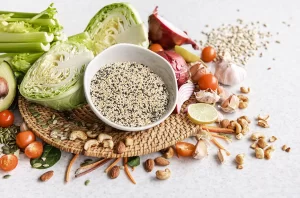Everyone goes through plateaus. The good news is that most stalls can be traced down to a few patterns that can be fixed and repeated. Here are the ten most common mistakes people make while trying to lose weight, along with easy, science-based strategies to fix them without having to start over.
1) Eating too few calories (and then bouncing back)
Aggressive deficits seem to be working…until they aren’t. Cutting calories too much makes you hungrier, more tired, and more likely to “compensate” eat, and it can also cause metabolic adaption, which means your body burns fewer calories than it should. That combination commonly leads to periods of rigorous eating followed by binge eating.
Think of biofeedback—energy, sleep, mood, training performance—as your dashboard. If those metrics dip for more than a week, raise calories slightly or add a maintenance day to steady the ship. Choose higher-volume foods (soups, salads, lean proteins, fibrous carbs) so your meals still feel big. A sustainable deficit is one you barely notice in day-to-day life.
How To Fix It:
- For long-term success, try to have a moderate deficit (like 300–500 kcal/day).
- After long cuts, use diet “deloads” (weeks of maintenance calories) to make it easier to adapt.
- To notice creeping consumption and make changes gently, keep track of weekly averages instead of single days.
BioMed Central
2) Not tracking how much you eat
We often get the sizes of our servings wrong and forget about “bites, licks, and tastes.” For decades, studies have shown that people who record their own food consumption often eat less than they actually do, even if they are trying to lose or keep weight. That gap could make up for the shortfall you planned.
Create simple “defaults” to reduce guesswork: a tablespoon for oils, a half-cup scoop for grains, a kitchen scale for proteins. Restaurant portions vary wildly, so assume entrées are two servings and box half before the first bite. Rebuild your “mental math” by recalibrating a few staple recipes with accurate measurements. Small errors add up—tightening three high-calorie items often restores your deficit.
How To Fix It:
- For two weeks, be honest about how much you eat or drink of important calorie sources including oils, dressings, sweets, and snacks.
- Don’t trust your memory; write things down as you go.
- Do “calorie audits” once a month to reset your eyeballing.
PMC
3) Not enough protein intake
If you don’t get enough protein, you’ll be hungry and lose muscle while you lose weight. Getting more protein (approximately 1.2–1.6 g/kg/day) while cutting helps keep lean mass and enhance body composition. Recent meta-analyses indicate that increasing protein intake during weight loss markedly reduces muscle loss.
Protein not only curbs hunger; it also has a higher thermic effect, meaning your body uses more energy to digest it. Aim to include 25–40 grams per meal, and watch how cravings fade between meals. Keep fast options on hand—cottage cheese cups, jerky, edamame, pre-cooked chicken, or tofu blocks. If mornings are hectic, blend a quick smoothie with Greek yogurt, frozen fruit, and milk.
How To Fix It:
- Add a protein source that is about the size of your palm to each meal (eggs, Greek yogurt, tofu, fish, chicken, lean beef, or tempeh).
- For better fullness, spread protein out over three to four meals.
- If you need to, add a basic protein supplement to reach your goal.
4) Not doing resistance training
Cardio burns calories now, but lifting weights safeguards your metabolism for the future. When you lose weight, resistance exercise keeps your fat-free muscle and strength. When combined with a calorie deficit, it’s one of the best ways to lower your body fat percentage.
You don’t need a bodybuilder split; two to four full-body sessions weekly is plenty. Focus on big movers—squat or hinge, push, pull, and a carry—then sprinkle in accessories. Track one simple progression variable each week (more reps, a tad more weight, or cleaner technique). Prioritize recovery with 48 hours between hard sessions for the same muscle group.
How To Fix It:
- Lift weights 2 to 4 times a week, working all of your major muscle groups.
- Make sure to do progressive overload, which is doing increasing reps, sets, or weight over time.
- Don’t give up all your lifts for lengthy runs; keep some cardio.
5) Slep Deprivation
Short sleep messes with hunger hormones (more ghrelin, less leptin), makes cravings stronger, and pushes people to choose higher-calorie foods, which makes it harder to stick to a diet. Studies suggest that not getting enough sleep and having your circadian rhythm out of sync might make it difficult to regulate your weight and make you eat more.
Treat sleep like an appointment: wind down with the same 20–30 minute routine each night. Cut caffeine after early afternoon and dim lights to nudge melatonin. Morning daylight exposure anchors your body clock and makes falling asleep easier at night. If naps help, keep them short (20–30 minutes) and before late afternoon.
How To Fix It:
- Set a sleep window that you can’t change (7 to 9 hours is a good goal).
- Wake up at the same time every day, turn off screens an hour before bed, and cool down the bedroom.
- If you keep track of your walks or calories, you should likewise keep track of your sleep. Treat it like a pillar, not a perk.
Nature
6) Eating mostly ultra-processed foods
Even when the macros, sodium, sugar, and fiber are the same on paper, ultra-processed foods make patients eat more and gain weight in randomized inpatient studies. The speed, taste, and texture of food can all make you want to eat more.
Design your environment to make better choices effortless: put produce at eye level and pre-wash fruits and veggies. Build meals that require chewing and time—crunchy salads, hearty stews, stir-fries with lots of veg—so fullness signals can catch up. When cravings hit, “upgrade” rather than white-knuckle it (e.g., popcorn for chips, frozen fruit for ice cream). Over a few weeks, your palate adapts and simpler foods become satisfying again.
How To Fix It:
- Make meals with whole grains, eggs, dairy, nuts, and unprocessed meats as the main ingredients.
- Snacks that “swap” processes, such trail mix instead of chips or Greek yogurt instead of ice cream.
- Stop eating quickly (put your fork down) to stop yourself from eating too much.
7) Drinking Your Calories (and Your Deficit)
Adults who drink sugary drinks are more likely to gain weight. Alcohol adds simple calories and can make meals more filling. Some people may not be able to cut back on their energy consumption even if they drink sweetened drinks with few or no calories because they make them eat more.
Audit what you sip on autopilot—coffee add-ins, smoothies, juices, cocktails—and decide which ones are truly worth it. Create go-to “mocktails” with seltzer, citrus, and bitters to keep the ritual without the calories. Remember that alcohol also loosens food restraint and can disrupt sleep, which compounds hunger the next day. Hydration is a quiet ally; most people feel better aiming for a steady intake across the day.
How To Fix It:
- Water, unsweetened tea or coffee, or sparkling water with citrus are the best choices.
- If you drink, make a weekly budget and stay away from “drink + appetizer + dessert” stacking.
- Log any drinks that have calories in them and evaluate if they’re worth the trade-off.
8) Not paying attention to NEAT (the calories you burn outside of the gym)
People who are on a diet often don’t realize that they are moving less. Non-exercise activity thermogenesis (NEAT), which includes all the standing, walking, fidgeting, and chores you do, can reduce a lot when you lose weight, which means your deficit will be smaller even if you keep working out. Structured exercise helps slow down these decreases.
Embed movement into routines you already do: park farther away, take stairs, pace on calls. Set soft alarms for two-minute stretch or walk breaks every hour to prevent “sedentary creep.” Consider a standing desk or a desk-cycle to add effortless calories burned. Think in “movement snacks”—three to six mini-bursts scattered through the day beat one big sedentary block.
How To Fix It:
- Set a realistic daily step goal, like 7,000 to 10,000, and stick to it on days off.
- Add “movement snacks,” such 5-minute walks after meals, standing calls, and stretch timers.
- While you’re on a diet, keep doing some resistance training to help you stay active all day.
9) Letting the weekends undo the weekdays
Studies reveal that a lot of people who are trying to lose weight eat more and move less on the weekends, which stops fat loss or even makes them gain a little weight, which cancels out progress made during the week. The “over-restrict to make up” habit on Monday then starts a binge-restrict loop.
Plan your social calendar like training: anchor one protein-forward meal and schedule an active outing. Scan menus beforehand and decide on your main and one treat to avoid last-minute impulse stacks. Bring portable options for travel days—protein bars, fruit, nuts—so hunger doesn’t force a drive-thru detour. Celebrate wins with non-food rewards: a new book, a massage, or gear you’ll actually use.
How To Fix It:
- Plan two “flex” meals ahead of time for each weekend and stick to the rest of your regimen.
- To keep your appetite in check, follow the protein + produce guideline during the first meal of the weekend.
- On Saturdays and Sundays, stick to your movement goals, like going for a long walk or making arrangements to be active.
10) Putting the blame on yourself when it could be your meds or your thyroid
Some common drugs, like some antipsychotics, antidepressants, beta-blockers, insulin, and corticosteroids, can make you gain weight. Hypothyroidism can cause little weight gains and less energy use. It can be treated, but it’s worth checking to see whether the symptoms suit. None of this makes losing weight impossible, but it does affect the rules.
Map a simple timeline: when did your weight or appetite change relative to starting a medication? Bring that log to your clinician and discuss alternatives, dosing, or supportive strategies. Ask about a basic thyroid workup if symptoms line up—fatigue, hair/skin changes, cold intolerance, constipation. Regardless, double down on strength training and protein to protect muscle while you and your provider fine-tune the plan.
How To Fix It:
- If you gained weight after starting a new medication, talk to your doctor about weight-neutral options. Never discontinue taking a medicine on your own.
- If you have symptoms like tiredness, being cold intolerant, dry skin, or an unexpected shift in weight, inquire about a thyroid panel (TSH) and follow-ups as needed.
- When you have to take medication, double down on protein and resistance training to keep your muscles and metabolism strong.
Bonus: The scale is a sign that things are going wrong.
The daily weight is noisy because water, sodium, hormones, stool contents, and glycogen can modify the readings by several pounds without changing the fat. Stored glycogen is always connected to at least 3 grams of water, which is why high-carb meals may make the scale go up rapidly and low-carb days can make it go down without losing fat right away.
Better ways to keep track of progress
- Instead of weighing yourself once a week, use a 7-day weight average and trend line.
- Every two to four weeks, take measurements of your waist and hips and send in progress photos.
- Logs for performance (reps, sets, tempo) and energy (sleep, stress).
A Simple, Long-Lasting Plan (Putting It All Together)
The 5–5–5 Model
- 5 anchors a week: 2–4 resistance exercises and 1–3 fast aerobic sessions.
- 5 things to do every day: eat protein (1.2–1.6 g/kg), get at least 30 g of fiber from whole foods, reach your steps goal, and get 7–9 hours of sleep. Be sure to log your food consumed for 5 minutes.
- 5 weekend rules: plan to move around, plan two “flex” meals, stick to your breakfast routine, document special dinners and beverages ahead of time, and have a protein-rich snack at home after the event.
PMC
A week of “defaults” (for example)
- Breakfasts: Greek yogurt with berries and nuts; an omelet with vegetables and toast.
- Lentil-grain bowls and tuna or tofu salad wraps are what we eat at lunch.
- Dinner ideas include salmon or chicken on a sheet pan, beans and rice with salsa, and tempeh stir-fry.
- Cottage cheese, jerky, edamame, and fruit are all good snacks.
- Water, coffee, tea, and seltzer are drinks.
Quick FAQ’s
“Do I have to stop eating carbs?”
No. Carbs might affect your water weight and hunger, but whole-food, fiber-rich carbs are fine to eat when you’re on a deficit. Focus on sources that are only slightly processed and provide enough protein.
“Is it better to fast every now and then?”
It’s a tool, not magic. Some people do better with time-limited or alternate-day regimens, which can boost results just by being consistent. Pick the framework that you can keep up with.
“How quickly should I lose?”
Most of the time, losing fat in a healthy way means losing 0.5 to 1% of your body weight each week. Expect some weeks to go slower and some to stay the same. Don’t look at progress every day; look at it every four weeks. (See the glycogen/water section for an explanation.)
Final Key Takeaways
You don’t need a whole new plan; you only need to stop the leaks. Eat enough protein, lift weights regularly, get enough sleep, eat mostly whole foods, keep your NEAT high, and protect your weekends. Change your surroundings (and what you expect) first; the scale will catch up.










